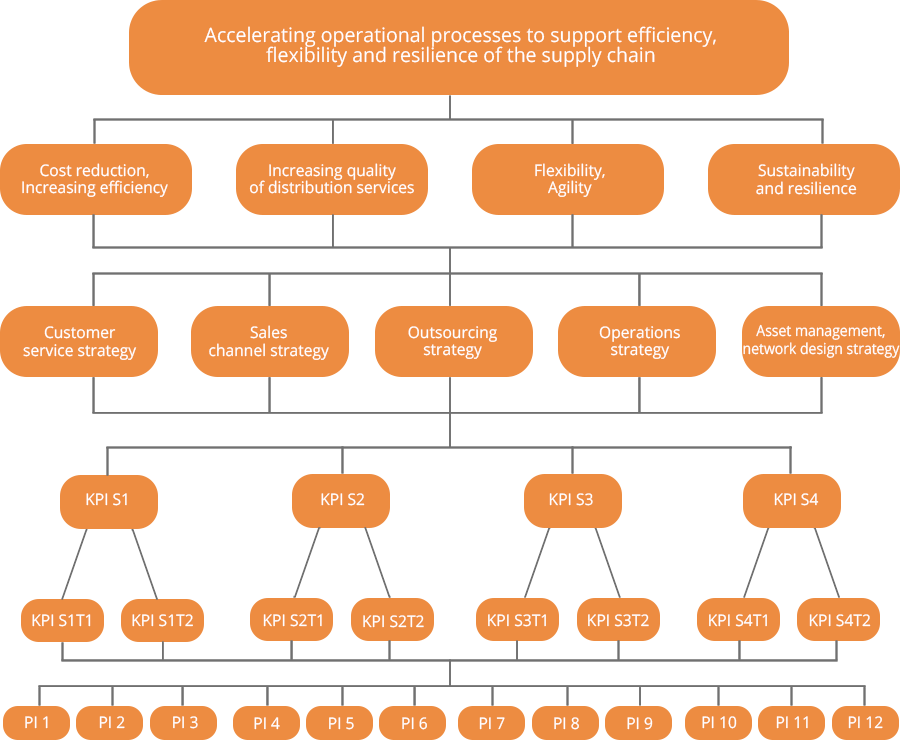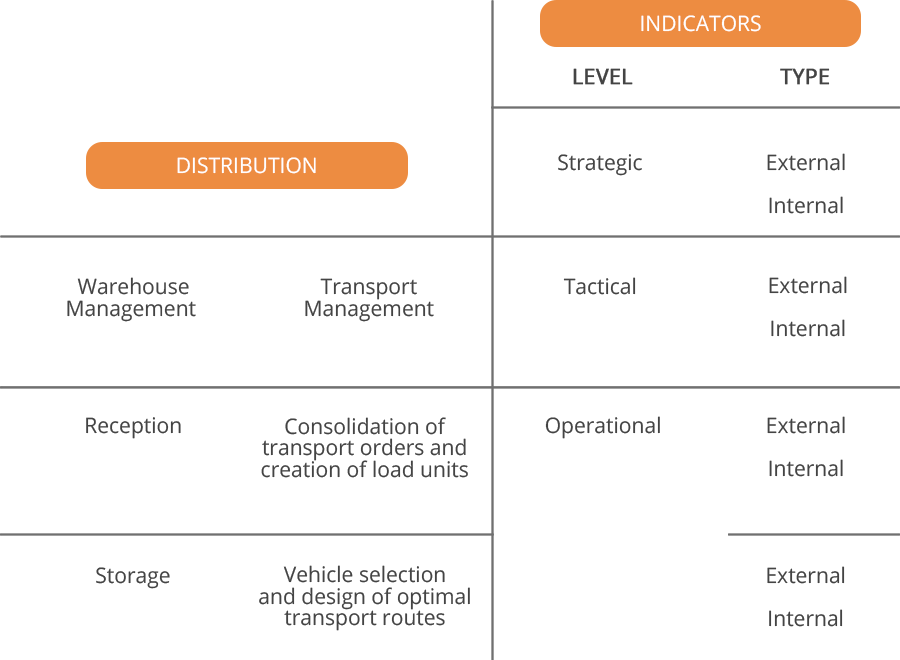Logistics specialists recommend applying the following rules when building the set of KPIs for evaluating performance of supply chain system:
6 rules for establishing the correct set of KPIs in evaluating supply chain performance
Align KPIs with the company’s mission, objectives and supply chain strategies
The key performance indicators (KPI) must be aligned with the new supply chain strategy and monitor SC performance in relation to its mission and objectives, according to fig. 1.

Fig. 1. Alignment of KPIs with the company’s mission, objectives and supply chain strategies
Use cross-functional and functional KPIs to develop collaborative work structures
A flexible and operationally agile company is built on cross-functional, multi-disciplinary teams that will focus on key process activities related to supplier relationships and customer requirements.
In order to develop interdepartmental, interfunctional collaboration and implement change management towards a collaborative internal and external structure, the performance of these teams will be evaluated through a set of composite indicators with different objectives: cost, financial, customer service etc.
For example, in this period of time when “cash is king”, use the strategic and composite indicators SCOR Cash-to-Cash Cycle Time and Order to Cash Cycle.
Both strategic indicators encourage cross-departmental collaboration and allow the following functional departmental structures to see their own contribution to the overall performance of the supply chain:
Establish an appropriate number of indicators – avoid excess KPI indicators
As shown in figure 1, do not set too many supply chain objectives, 3 or 4 are enough. Too many objectives lead to a confused definition of the supply chain mission. With too many indicators you will end up not seeing the forest for the trees.
For example, one objective for costs, asset efficiency, one for the quality of services offered to clients, one for flexibility, agility in relation to dynamic changes in demand, one for resilience and sustainability.
Apply the rule of having 3-4 key tactical and strategic indicators for each strategic supply chain objective so that at the operational level you do not have more than 10-12 indicators, as can be seen in figure 1.

Define a hierarchical and correlated KPI system for evaluating multiple objectives
A supply chain supports multiple objectives whose evaluation is done through a hierarchical and correlated set of KPIs. How to apply the right ones?
Do not use too many hierarchical levels. Three hierarchical levels are sufficient for monitoring and controlling SC performance: strategic, tactical and operational.
External performance indicators focus on the efficiency and flexibility of the company to receive and deliver products and services from or to supply chain partners.
Internal performance indicators evaluate the efficiency, sustainability and resilience of internal supply, production and distribution processes.
In fig. 2 we have a TOP-DOWN hierarchical structure of DISTRIBUTION process for representation of internal and external performance indicators.

Fig. 2. TOP-DOWN hierarchical structure of performance indicators
The basic objectives of logistics management in today’s commercial companies are focused on:
- Significant reduction in supply chain operating costs
- Increasing the quality of services for the company’s customers

In order to make correct decisions for logistical support of multiple competing objectives, in our case “cost reduction” vs. “increasing the quality of services for clients”, use the principle of trade off, of compromise.
For example, to monitor the performance of deliveries to customers on multiple competing objectives, service time vs. low costs, i.e. High-Service Providers, Low-Cost, apply the trade off principle using the cost and delivery time indicators together.
Applying in this case the trade off principle in establishing the set of indicators for monitoring multiple competing objectives, the orders intended for road transport will no longer be delivered on time using air transport, because the use of an expensive mode of transport will no longer respect the trade off principle High- Service Providers, Low-Cost.
It should be noted that establishment of a single cost performance objectives of supply chain during the pandemic led to its lack of resilience.
Set out targets on each As-Is, To-Be indicator
The evaluation report of performance objectives will contain the current values of indicators (AS-IS), the planned target values (TO-BE), the performance differences compared to the established targets, the link to the corrective action procedure in case of failure to achieve the targets TO BE performance objectives.
For TO BE performance target values, use standards established and published by companies that operate in the same industry and have similar turnover and supply chain characteristics. Comparable supply chains have the following similar elements:
- Product range
- Number of product lines
- Total number of items (SKUs)
- Functional, homogeneous products (general, mass production, low degree of innovation)
- Non-homogeneous products (modular architecture, high degree of customization and order configuration, innovative products)
- Variability of demand by product range (small – stable and predictable, large – volatile)
- Product life cycle (short, long)
- Product positioning, respectively the importance of product in portfolio on various criteria (sales, profitability etc.)
- Modes of transport
- Geographical footprint of supply chain network: number of warehouses/distribution centers, stores, other facilities
- Types of sales channels – B2B vs B2C
- Product handling and cold chain requirements
- The number of customers
- Orders profile
The correct set out of TO BE target values will allow the company’s management to understand how efficient its logistics chain is in comparison with others supply chains of similar companies or with the operational standards of BestInClass companies.
Use standard indicators in measuring operational performance of supply chain
For example. The SCOR model contains 800 indicators and these standard indicators, being recognized by your supply chain partners, can be used in negotiation of penalties, discounts, buy-back policies etc.
You have read Article 3 of the Series “Logistics trends and strategies in 2022”
From the fourth article you will find out how operational challenges in the supply chain field can be effectively overcome.







